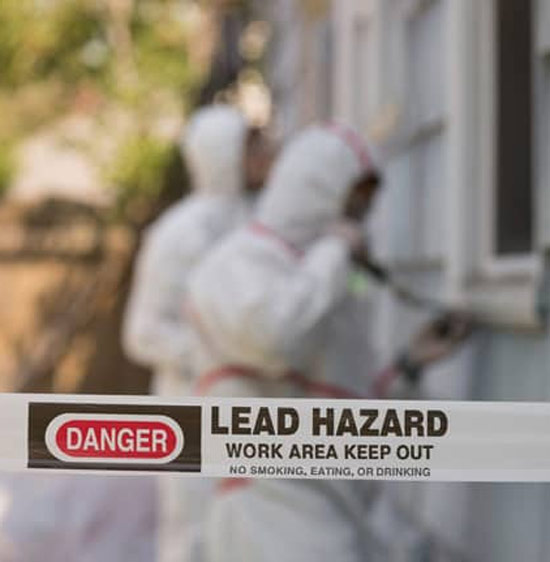NYC Lead Paint Removal Company-- Making Sure Safe and Lawful Compliance
NYC Lead Paint Removal Company-- Making Sure Safe and Lawful Compliance
Blog Article
Comprehensive Guide on Effective Lead Offense Elimination Methods
In the realm of ecological security, attending to lead violations demands a thorough and structured strategy. This comprehensive guide begins by highlighting the vital preliminary steps of recognizing lead dangers through innovative evaluation and screening approaches. Methods such as XRF evaluation and dirt clean sampling are essential in determining contamination resources. The overview elaborates on the significance of adhering to stringent safety and security methods during the elimination procedure, including the use of appropriate PPE and separating influenced locations. The succeeding areas promise to discuss post-removal confirmation and precautionary methods, ensuring long-lasting safety and security and compliance. Discover the elaborate information that make these methods not just effective however crucial.
Determining Lead Dangers
Identifying lead threats is an important initial step in minimizing the threats associated with lead direct exposure. Lead, a hazardous steel, can be existing in numerous environmental tools, including paint, dirt, water, and dirt.
The preliminary stage in recognizing lead threats entails understanding typical lead sources within the developed setting. Frameworks built prior to 1978 are specifically prone due to the widespread use lead-based paint during that duration. In addition, dirt contamination can occur from weakening outside paint, commercial emissions, or historic use leaded gasoline.
Another substantial source is lead piping and plumbing fixtures, which can seep introduce alcohol consumption water. Customer items such as playthings, porcelains, and imported products might likewise have hazardous lead degrees. Notably, occupational environments and hobbies including lead can track impurities into homes.
Evaluation and Testing
When addressing lead risks, reliable evaluation and screening are vital. This crucial step makes certain the identification and metrology of lead visibility, consequently guiding subsequent removal initiatives. Preliminary assessment usually involves an aesthetic examination to identify prospective lead sources, such as degrading paint or polluted dust. This is enhanced by even more rigorous screening approaches to establish the degree of contamination.

Dust clean sampling is one more essential technique, specifically in residential settings. By accumulating samples from floors, windowsills, and other surface areas, this approach provides insights into prospective direct exposure risks. Moreover, soil testing around building perimeters is necessary to detect lead contamination that could pose hazards, particularly to children.
Safe Elimination Treatments
Upon finishing home complete analysis and screening, carrying out risk-free removal procedures is the following essential stage in resolving lead dangers. This procedure guarantees that lead-contaminated materials are effectively and securely gotten rid of, decreasing danger to both workers and residents. The first action includes isolating the affected location utilizing plastic sheeting and proper securing methods to avoid the spread of lead dust.
Employees need to don appropriate individual protective equipment (PPE), consisting of respirators, gloves, and disposable coveralls, to minimize exposure. Using specialized devices and wet approaches, such as wet fining sand or utilizing HEPA-filtered vacuums, lowers the diffusion of lead particles. It is critical to prevent dry fining sand or abrasive blowing up, as these methods can create damaging lead dirt.
Waste disposal is another crucial component; all polluted materials need to be securely gotten and labeled according to EPA and regional regulations. Furthermore, detailed cleansing of the workplace with HEPA vacuum cleaners and wet cleaning ensures the elimination of recurring lead bits.
Post-Removal Confirmation

Verification of successful lead elimination, recognized as post-removal verification, is necessary to guarantee the safety and security and habitability of the remediated location. This evaluation makes certain that all known sources of lead have been addressed and that no noticeable indicators of contamination continue to be.
Adhering to the aesthetic assessment, environmental sampling is conducted. This entails collecting dirt, dirt, and occasionally water samples from the remediated location. Recognized labs evaluate these examples to gauge lead degrees, i was reading this ensuring they drop listed below the safety and security thresholds developed by governing bodies such as the Environmental Protection Agency (EPA)
Additionally, air quality screening might be performed to detect airborne lead particles, especially in instances where extensive lead-based paint elimination or renovation has actually happened. The results of these tests supply quantitative information verifying that the lead levels are within acceptable limits.
Eventually, post-removal verification functions as a crucial checkpoint, confirming the effectiveness of the lead abatement efforts and guarding the health of owners and visitors.
Safety Nets and Maintenance

An essential preventive measure includes making use of lead-safe accredited service providers for any type of improvement, repair service, or painting tasks. These specialists are trained in methods that decrease lead dirt and particles. In addition, maintaining painted surfaces to prevent chipping or peeling off is crucial, as deteriorating paint can release lead bits into the atmosphere.
Educational efforts targeting homeowner and renters pertaining to the threats of lead and the significance of reporting any type of possible hazards can even more improve preventative initiatives. Regular cleaning using HEPA vacuums and wet mopping methods can dramatically reduce lead dust accumulation.
Final Thought
In recap, reliable lead offense elimination demands a meticulous approach encompassing extensive evaluation, exact screening, and rigid elimination treatments. Making sure security with appropriate isolation and personal protective equipment remains paramount. Post-removal verification via ecological tasting and air top quality screening corroborates compliance with recognized safety standards. Continuous inspections and upkeep are necessary to alleviate future lead risks, therefore guarding public health and wellness and ensuring continual compliance with governing demands.
Report this page